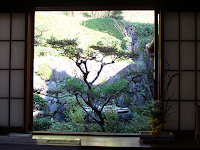Koya-san 高野山 and a temple stay
根本大塔:Konpondaitou, one of the main temples in Koya-san, built in 887 C.E.
 A few weekends ago I went to one of Japan's most sacred places
A few weekends ago I went to one of Japan's most sacred placesand UNESCO World Heritage site, Koya-san (Mt. Koya), upon which Shingon Buddhist sect was founded in Japan in 819 C.E., about 1200 years ago. Shingon was Japan's first significant taste of Buddhism, interpreted by Kobo Daishi, who had spent 20 years meditating and studying in China. Shingon Buddhism incorporates many esoteric symbols and practices, such as the painting of mandalas and ritualistic chanting of mantras, which Shingon monks practice repeatedly on their paths to enlightenment.
 High up in the Kii mountain range that straddles the borders of Wakayama, Osaka, and Nara prefectures, Koya-san looks out over the the Yamato plains, where modern Japanese society first began. The temples here on Koya-san are some of the oldest in the country, and the 800m high town now consists of over 120 temples, more than 50 at which visitors can stay the night and participate in the morning prayer rituals with the monks. All Shingon monks observe a strict vegetarian diet, known as 精進(shojin).
High up in the Kii mountain range that straddles the borders of Wakayama, Osaka, and Nara prefectures, Koya-san looks out over the the Yamato plains, where modern Japanese society first began. The temples here on Koya-san are some of the oldest in the country, and the 800m high town now consists of over 120 temples, more than 50 at which visitors can stay the night and participate in the morning prayer rituals with the monks. All Shingon monks observe a strict vegetarian diet, known as 精進(shojin). I went by myself to Koya-san on a spiritual journey to get in touch with myself and contemplate the role I want to play in my relationships, and in the world. I'm still uncertain as to what exactly I discovered, but wandering through the temple grounds and feeling the cool, sunset air surrounded by the tall shrines of cedars, pines, and boddhisattvas brought me somewhat closer to a peace I can live with.
I went by myself to Koya-san on a spiritual journey to get in touch with myself and contemplate the role I want to play in my relationships, and in the world. I'm still uncertain as to what exactly I discovered, but wandering through the temple grounds and feeling the cool, sunset air surrounded by the tall shrines of cedars, pines, and boddhisattvas brought me somewhat closer to a peace I can live with.Jizo: the stone dolls who lift the burden of children who die before their parents. Children who die young are said to not have accumulated enough good action in their lives, and therefore cannot pass into the afterlife. the Jizo take the place of that burden, which otherwise the souls of dead children must overcome by piling stones eternally on the bank of the river that separates them from the afterlife.
A wood carving done by the monks at the temple I stayed in.
Inside the temple's shrine.
Inside the temple where I stayed the night
 Looking out the window of my room
Looking out the window of my room
0 Comments:
Post a Comment
<< Home